Roman Provincial Coinage Contemporary Imitations of Roman Republican Coins
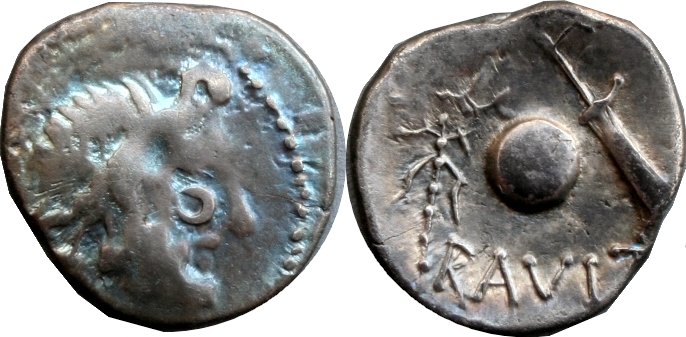 |
Links to Roman Provincial Coinage; Contemporary Imitations of Republican Coins
- Discussion and Pictures of Coins: Roman Provincial Coinage
- Lampsacus and Parium: a Tale of Twin Cities
- Discussion and Pictures of Coins: Imitative and Local Small Change
- Imitations of Roman Republican coins from Dacia
- Book Reviews: Provincial, Imitative and locally made small change
Coins: Roman Provincial Coinage
Click on any photo to see that coin. Or click on the right-hand blue link to see the entire set.
Roman Provinces
Click for SLIDE SHOW of these coins
Click for DETAIL VIEW of these coinswww.flickr.com
![]()
Roman Provinces
The Romans famously left the governance of their provenances well-alone provided they stumped up with their annual tax revenues. Thus for much of the period of Roman conquest, their influence on provincial coinage can hardly be seen. So the exceptional coins in this set are marked precisely because they show Roman influence. These include sample new-style Tetradrachms from Macedon and Athens, these having been introduced under Roman governance. One of these is the much studied coinage of Aesillas the Quaestor. Panormus in Sicily issued an extensive coinage of Janus-headed Asses with sometimes Roman typology - wolf and twins, magistrates names. Late in the Republic there are sporadic issues in the names of magistrates, imperators and Roman warlords in the eastern provinces, of which the proconsular cistophori in the name of magistrates of the province of Asia are particularly interesting. Spain issued an extensive series on the Roman standard, including the Spanish denarius, for 150 years. Many of these are proto-Roman, for example Saturn-prow semisses with magistrates names, of tolerably good style. Really these were probably regular Roman coinage. Was it likely that small change would be shipped from Italy? No, of course not, and the issues in this set - as distinct from the (imitative) local small change issues - were probably Roman. Finally, the latest Roman province, further Gaul, issued dupondius from several cities in imperatorial times, showing in each case the head of Octavian sometimes with that of Julius Caesar, or Agrippa. These however I included in the set with the triumviral coinages. These early provincial coins were the genesis of a tradition that would extend for three hundred years. Before they settled on a routine design basis, some of these were of extraordinary interest and beauty as shown in the next paragraph:
Lampsacus and Parium - A Tale of Twin Cities
Early Provincial coinages sometimes commemorated the founding of a city that later hardly appears in the numismatic record. Being commemorative, founding coins might be of higher artistic and manufacture quality. A classic example is the twin sets of coins inscribed CGIP and CGIL from the Propontis of Asia Minor, some bearing the head of Julius Caesar as well as magistrates names and titles that suggest a founding event. The coin below is a specially magnificant example, a 16mm bronze like a small rosebud that gradually unfolds to reveal more beautiful petals than one could imagine from such a tiny source.
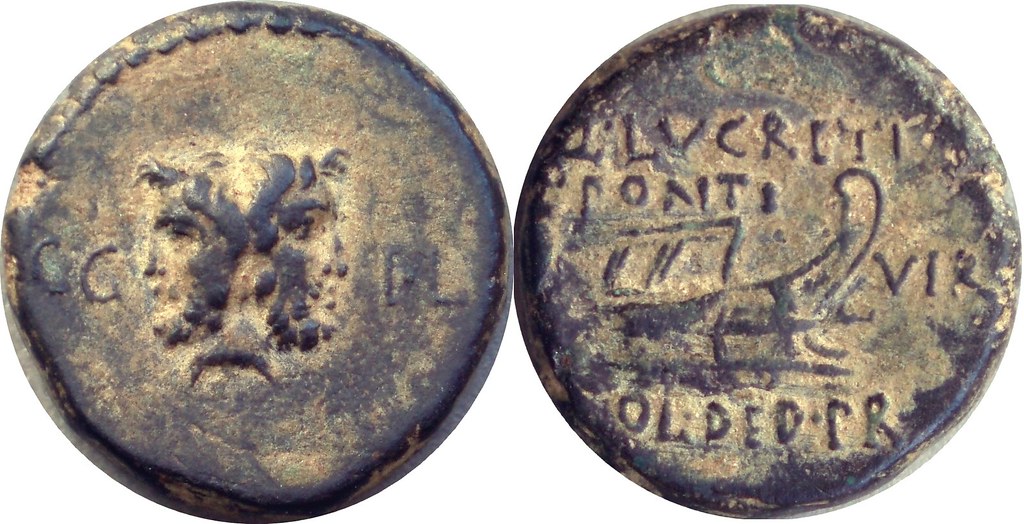
To start with, this is one of the most finely engraved bronze of such small module in the Republican series. The head of Janus is all of 5mm in width, the delicate lettering C.G.I.L. would not stand more than weeks normal circulation, the reverse is a wealth of details, the flan is round, thick and even, the strike well centred and strong from unworn dies. Next the types. It cannot be anything except an As, whose Janus/prow types have a genesis two centuries earlier, with the first Janus/prow As on a libral one pound standard, weighing some 100 times as much with the same nominal face value.
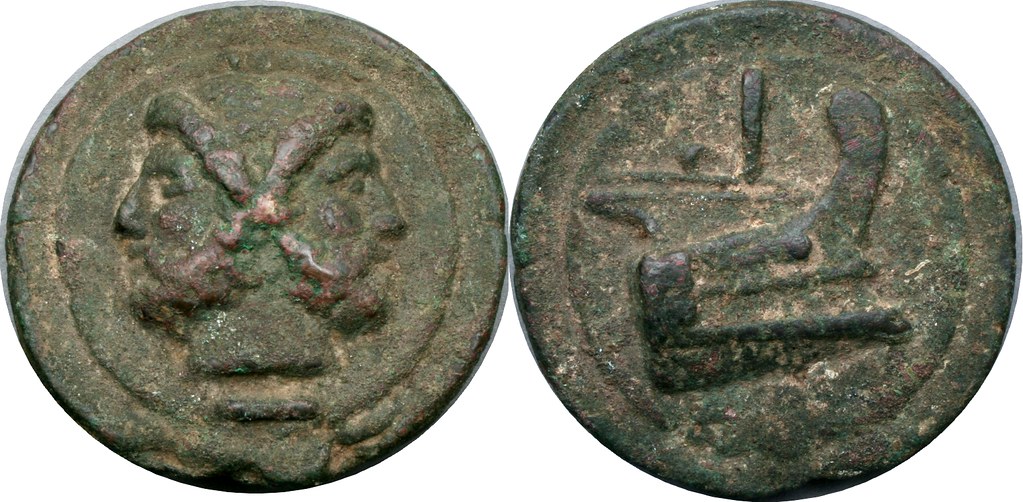
But by the time of Julius Caesar, no Janus/prow Aes had been struck since the bronzes of Sulla some forty years earlier. The Janus-prow type was familiar as a monetary concept but not as new currency. In fact other than rebellious issues of Sextus Pompey, no further Janus-prow bronzes were ever to be struck with the exception of an excessively rare type of Mark Antony, Crawford 530. So this is remarkable, commemorative and with an ancient type quite appropriate for a founding coinage and apparently issued in very small quantities. RPC2273, which is the type, is cited in only two examples, one acquired by the British Museum in 1866, the other in collection RW. Both these coins, as well as this third example, share a single obverse die with another equally rare issue. This is rather nicer than the RPC illustrated BM example.
So what does C.G.I.L. stand for, and what does the reverse legend indicate? A clue is provided by another similar set of coins also Imperatorial and from the Propontis, with the legends C.G.I.P. Michael Grant in From Imperium to Auctoritas considered the two series together. The portrait coins of Julius Caesar with the legend C.G.I.L. are of the earliest realistic Caesarian portraiture. Caesar's presence in Asia Minor after the defeat of Pompey in 46BC suggests that the C.I. stand for Colonia Julia, ie colony in the name of Julius Caesar. A clue is provided by the title of this essay.. twin cities. Grant hypothesised that G stands for Gemina or twin, and thus the two legends read "Twin Julian Colony of L..." and "Twin Julian Colony of P...". The colonies may have been jointly garrisoned by a single legion or by twin legions, perhaps even formed by ex-legionaries since historically land grants were used as end of service benefits. Thus the ties between the cities formed perhaps a much stronger bond than modern sister cities, that of current or ex comrades in arms. Whilst the L... coins are all rare, some of the P... coins are quite common, most notably the following small denomination type RPC2259, likely a semis, which although not bearing the full legends is clearly associated by the female head / jug type as well as by the C.G.I.P. obverse legend, with larger denominations which have more detailed legends. The reverse letters likely stand for Decurionum Decreto (by decree of the decurions, i.e. the city senate).

The identification of P... is easier due its large coin volumes and the fact it struck later issues, it is Parium, a Greek city in Mysia on the Hellespont. Grant says "We must look for a Julian colony, with the initial L, near Parium. It has escaped notice that just such a colony existed, albeit for a very short time, at Lampsacus". The colonial venture (as distinct from the town itself which was a much more long lived entity) seems to have come to an end with the Asiatic adventure of Sextus Pompey in 35BC who occupied the town, and its very short existence as a Roman colony seems to have escaped the notice of previous numismatists. Finally, consideration of a colonial foundation scenario reveals the reverse legend of the Lampsacus. Colonia Gemina Julia Lampsacus, Q. Lucretio, L. Pontio, Duoviri, Colonia Deducta Prima. Twin Julian Colony of Lampsacus, Q. Lucretio, L. Pontio, Duovirs, first Colony founders. And that of the illustrated Parium, Twin Julian Colony of Parium, by Decree of the Decurions. QED.
Imitative Coins and Locally made Small Change
Click for SLIDE SHOW of these coins
Click for DETAIL VIEW of these coins
www.flickr.com
![]()
Locally made small change
Locally produced coinages are amongst the main current study interests in the Roman Republic. It is a fast developing field and several experts are worth noting: Phil Davis for his work on Dacian imitation denarii of the first century BC, Clive Stannard for his work on the small change of Italy, Kris Lockyear for the export of Republican coins to Dacia, and Robert Freeman for Eraviscan copies of Republican coins. All have published in journals (in the case of Stannard and Freeman also in Essays Hersh). However by good fortune, Clive, Phil and Kris each have made their work available on the internet. That of Clive Stannard can be downloaded from http://web.me.com/clive.stannard/1 and the developing work of Phil Davis can be found on http://rrimitations.ancients.info/. Kris can be found on http://eprints.ucl.ac.uk/4832/1/4832.pdf . The missing element of the picture, still to be studied and hardly touched since Crawford's account in AIIN29 in 1982, is semi-official imitations, sometimes rather good so one wonder how unofficial, of official Republican bronzes in Italy and, separately, in Spain. Several are included in the linked set of coins here. This is in need of study, it's vacant space with lots of published material and lots of country-specific source evidence (not only published archaeological finds but also considering the strong circumstantial information provided by the relative different offerings of local small change on ebay.it and ebay.es which cannot be ignored as a source of historical evidence, whatever one's views on how such coins came to the market place). The Kestner-Hannover catalogue provides a lot of photographed material but no source data or commentary.
- Discussion and Pictures of Coins: Roman Provincial Coinage
- Lampsacus and Parium: a Tale of Twin Cities
- Discussion and Pictures of Coins: Imitative and Local Small Change
- Imitations of Roman Republican coins from Dacia
- Book Reviews: Provincial, Imitative and locally made small change
Imitations of Roman Republican coins from Dacia
I quote below a short extract from one of Phil Davis' recent studies on coins from Dacia, modelled on the Roman Republic, to give a flavour. Phil mentions that these coins were not intended to deceive, no more than the Italian or Spanish local small change was intended to deceive. They were good metal coins in as good a style as the makers could manage.
QUOTE.
Twenty-five years have passed since the late Maria Chitescu's groundbreaking
examination of Dacian imitations of Roman Republican denarii, Numismatic
Aspects of the History of the Dacian State.... These range from
very faithful copies, barely distinguishable from their Republican prototypes, to
wild, outlandish, sometimes dramatic, occasionally lovely barbarous interpretations
of the Roman original, to remarkably crude depictions of cartoon Roma heads
and stick-figure quadrigas that hardly merit the term, art, at all.

They are in no
sense counterfeits; their purpose was not to deceive or cheat the recipient, and
in fact, the imitations often contain more silver by weight than their Republican
models. Rather, they served to make up a shortfall, real or perceived, in the supply
of circulating coinage in Dacia, much as local British imitations of Roman asses
of Claudius made up a deficiency of coinage in First Century AD Britain...
Coinage had long been known and used in Dacia, consisting largely of Macedonian and Thasian
tetradrachms and imitations of them; drachms of Dyrrachium and Apollonia also
circulated, primarily in Transylvania. As economic contact between the expanding
Geto-Dacian world and the expanding Roman Republic intensified, perhaps as
early as 100, more likely circa 75 BC, these Greek issues were almost entirely
replaced by Roman Republican denarii....
K. Lockyear has demonstrated, by careful hoard analysis,
that Republican denarii began to arrive in quantity in Dacia in the mid-70s BC.
.... this corresponds nicely with the
date at which the prototypes of the most typical Dacian copies were struck. The
imitations will of course have been struck somewhat later than the prototypes,
since an indeterminate, but not negligible, time will be required for these to
arrive in Dacia. A timeframe ranging from roughly 80 BC to 65 BC for the issue
of the bulk of the imitations, with a second, smaller peak around 40-30 BC, will
perhaps be not far from the mark.
Massive numbers of apparently official Republican issues have been found
in Romania, some 25,000 in documented hoards, an unknown but substantial
number in undocumented finds, more than have been unearthed anywhere outside
Italy itself. These hoards are found in all regions of modern Romania. M. H.
Crawford has described this as one of the most remarkable phenomena within
the pattern of monetary circulation in antiquity...
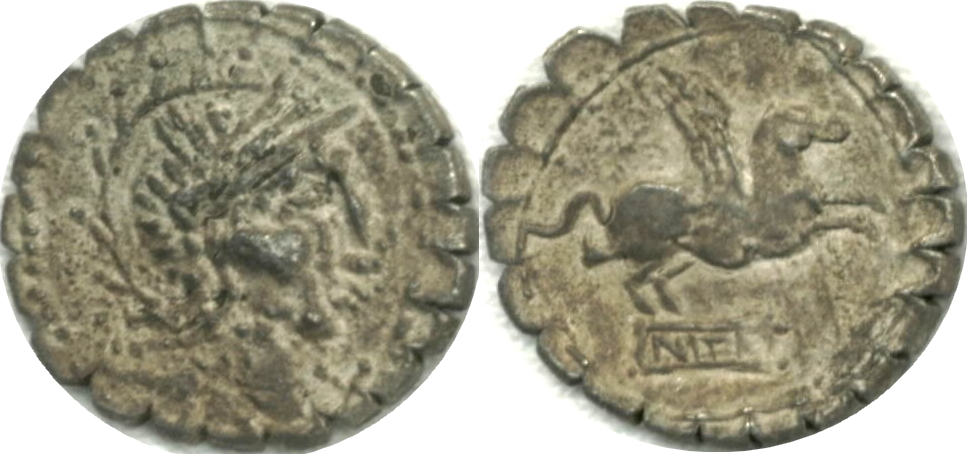
These hoards contain a mixture of official Republican coins and locally made imitations of them. Just what the proportions of that mixture are has been the subject of sometimes heated debate. Chitescu and other Romanian scholars argued that the proportion of locally produced coins was surprisingly high, Crawford countered that it was quite low. That some of these coins are imitations is beyond dispute, as evidenced by their non-Roman style and garbled legends. Most however, give every appearance of being normal products of Roman mints... Chitescu and other Romanian scholars maintained that this flood of coins was due in large part to the economic requirements of the Dacian proto-state under Burebista. In this view, the coins were needed to fuel an expanding monetary economy and to pay Burebistas army. Contra this, Crawford suggested that the primary explanation for the influx was the requirements of a growing slave trade between Dacia and Rome, necessitated by the dearth of slaves in the Republic after the bloody destruction of Spartacus slave army in 71 BC and Pompeys repression of piracy in 67BC. This fractious debate has generated more heat than light... My intent here is to focus on the coins themselves, specifically those that were without doubt produced locally in Dacia... and examine particular Dacian imitations from a numismatic perspective. UNQUOTE.
Courtesy Phil Davis http://rrimitations.ancients.info/

Books: Roman Provincial Coinage and Imitative Coins
Essential
Any Republican numismatist who needs a basic understanding of coinage in the context of Rome's conquest of Italy and the Mediterranean should have these three books. RPC is a well known book but relies on FITA for much of its foundation research. Crawford’s CMRR is the glue that binds it all together, Rome, Italy and the Provinces, in a grand sweep of numismatic history.
Burnett, Amandry, Ripollès, Roman Provincial Coinage I. From the death of Caesar to the death of Vitellius, 2 vols, 1992
Roman Provincial Coinage - RPC1, separately reviewed in the Other Key References section, is essential.
From Imperium to Auctoritas, Michael Grant, 1946
From Imperium to Auctoritas - FITA, separately reviewed in the Other Key References section, is of value for any general Republican numismatics library, but perhaps RPC1 for the identification of Provincial types is a higher priority. However for anyone with a serious interest in the Provincial coinages, FITA is essential as it provides a large proportion of the analysis and text discussion that RPC1 relies upon.
Coinage & Money Under the Roman Republic: Italy and the Mediterranean Economy, Michael Crawford, 1985
Coinage & Money Under the Roman Republic - CMRR, separately reviewed in the Other Key References section, is essential to provide a proper perspective on the non-Roman coinage in the Roman world.
Important
These volumes are important reference works for any who take a serious interest in the development of coinage in the Roman world, but are of second order as compared to the three essential volumes above.
The Coinage of the Roman World in the Late Republic; Burnett and Crawford eds, 1985
These are the proceedings of a conference held in conjunction with the publication of Coinage and Money under the Roman Republic. Though their coverage is similar (the expanding Empire), the approach is different: CMRR provides an overview of the rise of Rome, and of the replacement of local by Roman coinages, whilst CRWLR takes the perspective of the "arrival" of Rome and subsequent impact on the coinage. It includes a province-by-province review of how coinage developed after the arrival of the Romans (except Italy – separately covered in Burnett’s 1982 article in AIIN). In the absence of RPC volume 0 for the period prior to 49BC this together with CMRR is the only substitute. Coverage includes South Germany, Spain, Sicily, Macedonia, Thrace (French), South Greece, Asia Minor, Syria (German), Egypt (Italian), Crete & Cyernaica, Africa.
SNG France VI,1: Italie, Etrurie - Calabre. Bibliotheque Nationale Dept. des Monnaies, Médailles et Antiques 2003
Invaluable for its 141 pages of plates illustrating many coins not pictured in HNI.
Unofficial Imitations and Small Change under the Roman Republic, Michael Crawford, AIIN29, 1982
The only dedicated reference to imitative bronzes of the
Republic, it is a provisional catalogue illustrated to a great extent from
d’Ailly. Other parts of AIIN29 are listed in the Minting and Money page.
Stannard (essays for Hersh, Local Coinages of Central Italy, and AJN20) and
Knapp (in Coinage of the Roman World in the late Republic) also deal with
imitative bronzes. The Kestner catalogue has a large number of unattributed
imitative bronzes. Still much work to do in this area. Warren Esty has a nice
site on imitative coins:
http://esty.ancients.info/imit/imitationrepAE.html
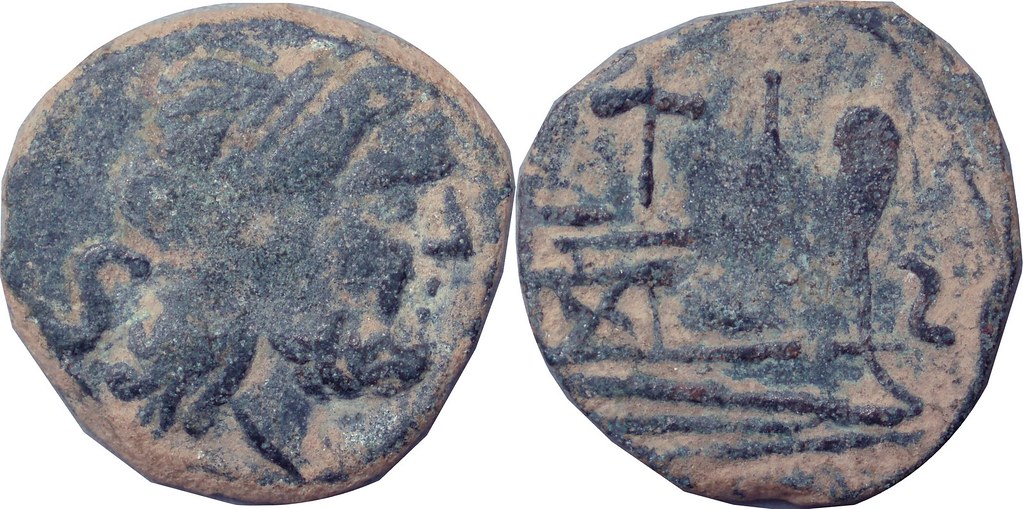
Coinage and Identity in the Roman Provinces, Christopher Howgego, Volker Heuchart and Andrew Burnett, 2004
A series of essays by current experts, based on papers given at a symposium in 2002, that both does a sweep around the Mediterranean as well as addressing common topics such as aspects of identity, and iconography. 32 good quality plates, 230 pages. A quite deep read that assumes some prior knowledge of the series but it would be a good companion volume to RPC. Whilst not focussed on the Republic, for which the Burnett and Crawford volume above is better, it contains much general background information about provinces and provincial coinage.
Pseudomints and small change in Italy and Sicily, Suzanne Frey Kupper and Clive Stannard, in AJN20, 2008
This integrates much of the work done by Clive Stannard over the last 20 years or so, on the Republican small change issues found in large quantities in southern Italy and Sicily, that are neither local city issues nor direct imitations of Roman Republican coins. Many of these are in fact imitations of coins foreign to the area, copies of Panormus, Ebusus and Paestum outside their home. It reaches a somewhat disturbing conclusion for Roman Republican students, that the official Roman coins were hardly available in much of Italy and local cities by preference copied coins that came available by trade rather than Roman coins. Furthermore somewhat contradicting Michael Crawford’s conclusions on the coins of Paestum (its function was almost frivolous), even in a well monetised city such as Paestum most circulating coins were local official issues and not Roman. A long and important essay that presents a new picture of coin circulation in Republican Italy. There is also a reminder that unofficial imitations of official Republican types, reference Crawford in AIIN29 above, remain almost wholly unstudied. Quote, The imitations of Rome, which in the 19th century were collected and studied, for example by d’Ailly, were subsequently ignored as unimportant, until Crawford pointed out their economic importance (in AIIN29). They deserve to be restudied. Unquote. You can download the study from http://web.me.com/clive.stannard/1
Of Interest
The following books will be of greater or lesser interest dependant on how far you draw the boundary of your personal interest in Roman Republican coinage. I would probably not go out of my way to purchase any of them as part of a standard library, however if you have them to hand they can be fascinating reading. For example the story of the coinage of Aesillas is relevant to those interested in the numismatic history of Greece and Macedon during the ascendency of the famous general and aesthete, Lucullus.
Roman Coins Outside the Empire, Ways and Phases, Contexts and Functions, Nieborow Poland, September 2005
Proceedings of a workshop on the patterns of influx and use of Roman Coins in barbarian territories. 37 contributions, written by 39 ancient historians, numismatists and archaeologists from 16 countries.
Silver Coins with the types of Aesillas the Quaestor, Robert Bauslaugh, ANS NS 22, 2000
The definitive die-study on these
coins, also addressing the CAE.PR and SVVRA issues, which resolves the dilemma
between early (90BC) and late (70-65BC) dating by coming to the radical
conclusion that the Aesillas coins were probably struck over an extended period
from 90-65bC.

Monetazione provinciale romana I Sicilia. Le emission tardo-repubblicane di Atratinus e la serie con ritratto do Octavianus Augustus e di Tiberius, Rodolfo Martini, 1991
Study of the Sicilian coins issued by Atratinus, plus other issues.
La Moneda Hispanica desde sus origines hasta el siglo V, Alvarez Burgos, Madrid 1987
Type catalogue of ancient Spanish coins, with line drawings. Completely superseded in my view by SNG BM Spain, but often cited and potentially cheaper than SNG BM Spain (see Important Catalogues).
Numismatische Studien zur Chronologie der Roemischen Statthalter in Kleinasien, Gerd R. Stumpf
The definitive work on pro-consular cistophori.
La circulation monetaire en Grece sous la protectorat de Rome, Adalberto Giovannini, AIIN 29, 1982
Monetary changes in Macedonia following the abolition of the monarchy and the imposition of Roman rule in 168BC.
The local coinages of central Italy in the late Roman Republic, Clive Stannard, 1994
Overstrikes and imitative coinages in central Italy in the late Republic, Clive Stannard in Essays Hersh 1998
Roman coins from the River Liri, W.E Metcalf NC 1974
Stannard’s studies address Italian small bronzes, based mainly on finds from the river Liri, south of Rome. These are a mixture of imitations of Roman bronze types, local Italian types and (most surprisingly and not yet understood) originals as well as imitations of colonial types from Panormus and Ebesus (Ibiza). Stannard’s studies, including these listed, can downloaded from http://web.me.com/clive.stannard/1
A group of Eraviscan denarii, by Robert Freeman in Essays Hersh 1998
Surveys some of the
better known imitations of Republican coins.

The Roman Republican Coinage in Dacia and Geto-Dacian Coins of Roman Type, Maria Chitescu, BAR International Series 112, Oxford 1981
A survey of Dacian imitations of Republican denarii found in Romania. Very difficult to find. Useful for its many photographs and hoard descriptions but the analysis has been superseded by the material and classification on Phil Davis’ website. http://rrimitations.ancients.info/ and the work of Kris Lockyear http://eprints.ucl.ac.uk/4832/1/4832.pdf
All content copyright © 2004-2011 Andrew McCabe unless otherwise noted. If you've any questions or comments please contact me on the Yahoo Group RROME: http://groups.yahoo.com/group/RROME.
Alternately you can leave comments against any coin picture, just click on the picture and write in the comment box.
See my rarity estimates for Roman Republican Bronzes: Roman Republic Bronze Rarities..